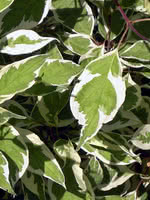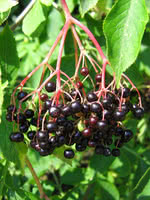Mon-Fri 9am - 5pm Mountain time
Variegated Dogwood vs Black Elderberry
Cornus alba argenteo-marginata
Sambucus canadensis
NOT AVAILABLE THIS SEASON - MIGHT RETURN
Variegated Dogwood is a small shrub that is often used in the first row of a shelterbelt, as a hedge, or for soil stabilization projects. It has the same distinctive red bark, white flowers, and berries as Red Osier Dogwood.
The key difference between the two is the leaves. Where Red Osier's leaves are green throughout, Variegated Dogwood has a white outline around each leaf, giving this shrub a distinctive look.
Black Elderberry is a deciduous shrub native to eastern North America. You can plant this shrub in moist areas and it will help stabilize your soil. You can also use it on rural properties anywhere you'd use a lilac.
Black Elderberries are considered to be partially self-pollinating. So while they will still produce some berries without cross-pollination, planting with another variety will increase yields. Consider planting with Ranch Elderberry or Bob Gordon Elderberry.
Warning: the seeds, stems, leaves, roots, and uncooked berries of the Black Elderberry are poisonous to humans when eaten in quantity. You should cook the berries to make them safe for human consumption.
Variegated Dogwood Quick Facts
Black Elderberry Quick Facts
Toxicity: leaves, stems, and uncooked berries are poisonous to humans

